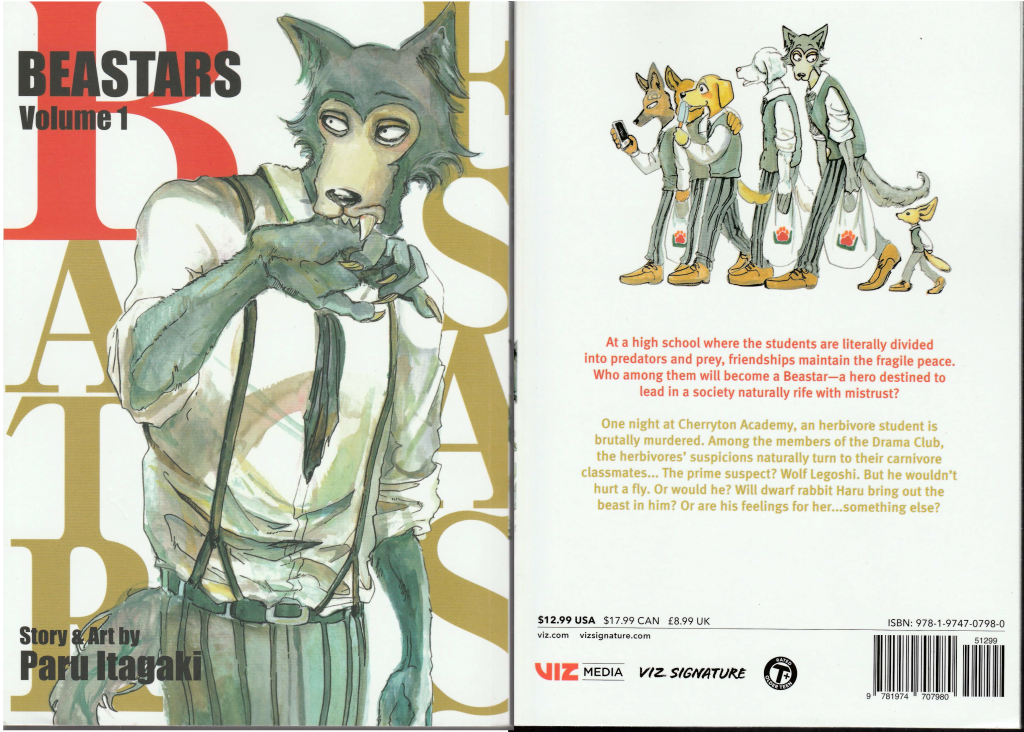





****
Beastars is a 2016 slice of life drama manga by Paru Itagaki. Presently erialized in Shounen Champion magazine, it has been picked up by Viz media and saw the English release of its first volume last month in July 2019. It’s garnered a fair amount of approval – so much so, that an anime adaption fronted by Netflix is in production and is set to release this October.

Paru Itagaki – A new name to add to the list. Beastars appears to be Itagaki’s breakout hit. Considering what I’ve seen of the series so far, she definitely deserves it. Her slice of life drama introduces weighty events, but the pay off is the slow burn of the aftermath and what it exasperates in the characters.
A Solitary Wolf… – The cover features our protagonist, Legoshi, prominently. Being a Gray Wolf, he’s tall and foreboding, but he’s also hunched over, as if shying away from something. We’re given reminders of his strength with his claus and fangs on display. However, he’s not bearing them at anyone so much as he’s passively restraining them to himself, biting his own hand. Legoshi is this portrait of raw potential held under a demure restraint.
Cherryton Academy is host to a very diverse student population. Carnivore and Herbivore species frequent the campus in a commendable harmony. Unfortunately, one of the herbivore students, Tem, is murdered one evening and a carnivore is suspected. The harmony that Cherryton enjoyed isn’t completely destroyed, but is it IS shaken. Who is responsible for Tem’s death? Why did they do it? Can Cherryton’s shaky balance weather the prejudice and distrust that’s bubbling to the surface?
Legoshi – A Gray Wolf, revealed to be the protagonist of the story. Large and scary to herbivores of Cherryton (especially after Tem’s demise), but he keeps to himself and doesn’t harm anyone.
Louis – A hardworking Deer well known and generally well liked by the student population. Good thing, considering he’s aiming to become Beastar, a unanimously liked leader figure amongst the student body.
Haru – Dwarf rabbit that’s been having a hard time of it lately due to some less than ideal attitudes amongst her Herbivore peers.
Anthropromorphic animals are not new (Space Jam, Robinhood and half of the Egyptian “Pantheon” says hi), but the last property of the sort to pop up on the pop culture radar was Disney’s Zootopia. So, while it pains me to admit it, comparisons are inevitable.
My chagrin not withstanding, Zootopia IS an apt jumping off point. But it’s worth noting that while Beastars CAN be considered Zootopia High, one needs to take care not to consider them too much alike. Beastars is to Zootopia what House of the Dead is to Resident Evil. That’s to say, they’re different approaches to the same premise.
Historical and Fantastic Racism have an interesting relationsthip. Historical Racism generally revolves around the othering and prejudicing of people based on ethnicity or nationality that then fuels the bad blood (by way of words, action, policy, etc.) between demographics. Fantastic Racism does much the same, but with fantasy races. As such, unlike Historical Racism which is dealing with one race (and thus an “even” evolutionary playing field), Fantastic Racism plays host to a broad swath of literally different races that inherently have characteristics that make them a danger to others and themselves. So the take away from Historical Racism is that prejudices based on race or nationality are never justified because those don’t make people different enough to warrant them, so we shouldn’t even entertain them. Fantastic Racism, poses a much taller challenge. Fantastic Racism at times asks us to acknowledge that others may very well have innate characteristics and tendencies that make them dangerous. Despite that, we should strive to live in harmony by making reasonable concessions and judging people by their actions.
With that in mind we see that Zootopia and Beastars are topically similar, but Zootopia cements itself as an analogy for Historical Racism through the fact that despite the number of different species and their noticeable differences, all are on even footing instinctually. Predators aren’t instinctively driven to harm prey anymore. Beastars, on the other hand is squarely Fantastic Racism. A lot of what we see are people’s prejudices and reactions to their fears, but Beastars makes it clear that these are justified somewhat and those instincts they fear haven’t washed out. But at the same time, you have a world that’s trying to account for that. Herbivores and Carnivores both attend Cherryton Academy, but they live in separate dorms and are expected to not enter the other. They share facilities and are expected to yield to or outright help each other with traversing them. They seem to trust them enough to have them in close proximity to each other each day but Carnivores that hurt Herbivores are expelled. It’s all taken to it’s logical extreme in the concept the manga is named after: the Beastar – a uniting leader meant to act as a mediator between the carnivores and herbivores at Cherryton. Calling it class president or student council president feels like an undersell. But like most things, its give and take.
Anyone who can unite people is worthy of some degree of honor and esteem. But that title is stated to also nearly guarantee further status and opportunity once you’ve graduated from the academy. The latest contender for the title of Beastar, Louis, shows us how disingenuous one can be in pursuit of it. I’m not here to say that Louis is an asshole or that Beastar is a useless title, just that that Deer makes you question what he really cares about at times.
It’s this duality that Beastars thrives on and it’s no different for our protagonist, Legoshi. He’s a big wolf that scares people but he’s caring and well spoken. He’s aware of how people feel about him, so he stays out of their way. Ironically, this just makes it worse because it looks like he’s sneaking around and his lack of initial explanation makes it easier to assume the worst. Legoshi sizes up opponents like any predator would but only uses that knowledge to plan the best way for him to lose while saving his opponent face. Most importantly, despite our growing sympathy for Legoshi, the whole volume is overshadowed by the heavy implication that a wolf (if not Legoshi himself) killed Tem and we’re burdened with wondering whether our precious fluff boy did it or not.
Beastars, for all intents and purposes, could’ve been a simple murder mystery with some topical social commentary. Thankfully, it wasn’t. Don’t get me wrong, justice for Tem is important, but his demise isn’t the shot that ends a fight so much as it’s the shot that starts the race and the real meat and potatoes of Beastars is what that brings to the surface. The fear, exasperation, politics – all of it. What arises in its wake is a story of the tense balance you get when a society can’t (or won’t) see you for who you really are. But it, sadly, is also a story of you losing faith in your self because, honestly, you can’t either….
Continue?:



